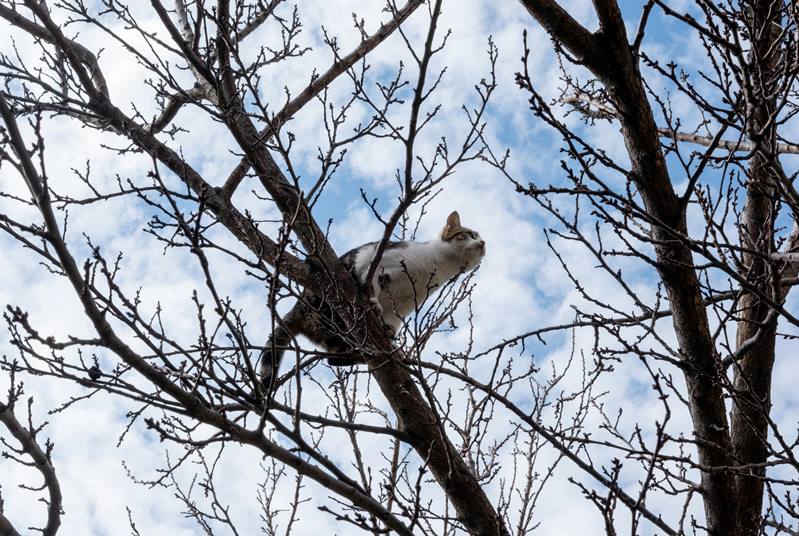In this Article
Cats are known for their affinity for high places, whether it's the top of a bookcase, a windowsill, or a tree. This vertical behavior is not just a quirky trait, but a deeply ingrained instinct shaped by evolution, psychology, and physiology. Understanding why cats are drawn to heights provides insight into their behavior and helps cat owners create environments that satisfy their pets' natural instincts. This article explores the reasons for cats' love of heights, supported by expert opinion and scientific evidence, and offers practical recommendations for cat owners.
Evolutionary Roots of Vertical Behavior
Cats' love of heights can be traced back to their evolutionary history. Domestic cats (Felis catus) are descended from wild ancestors, such as the African wildcat (Felis lybica), who thrived in environments where survival depended on keen observation and strategic positioning. Dr. John Bradshaw, an expert on feline behavior and author of Cat Sense, explains, "Cats are naturally ambush predators. Being in an elevated position allows them to observe potential prey or threats without being noticed."
In the wild, elevated perches offered several survival advantages:
-
Safety from predators: Elevated spots provided protection from ground-dwelling predators, allowing cats to rest without fear of attack.
-
Hunting Advantage: Heights allowed cats to see prey from a distance, plan their approach, and execute precise attacks.
-
Territorial Control: High perches allowed cats to monitor their territory and keep an eye out for rivals or intruders.
These instincts remain strong in domestic cats. Dr. Sharon Crowell-Davis, a veterinary behaviorist at the University of Georgia, notes, "Even in a domestic environment, cats seek heights to feel safe and in control. It's an inherited behavior that persists regardless of their domestic lifestyle.
Psychological Drivers of Altitudinal Behavior
Beyond survival, the psychology of cats explains their vertical tendencies. In the wild, cats are both predator and prey, creating a unique behavioral profile. Heights satisfy several psychological needs:
1. Sense of security
Cats are naturally cautious. Elevated areas provide a refuge where they can observe their surroundings without feeling vulnerable. Dr. Mikel Delgado, a certified feline behavior consultant, says, "For cats, height equals safety. Being up high reduces the chance of being surprised by a threat, whether it's a dog, another cat, or a loud noise."
Studies support this idea. A 2017 study published in Applied Animal Behaviour Science found that cats in multi-pet households often chose elevated resting spots to avoid interactions with other animals, reducing stress and conflict.
2. Territorial Confidence
Cats are territorial creatures, and height allows them to assert dominance over their environment. By claiming the highest point in a room, a cat can survey its territory and establish a sense of control. Dr. Carlo Siracusa, a veterinary behaviorist at the University of Pennsylvania, explains, "A cat on a high perch is essentially saying, 'I own this room. It's a way of reinforcing their status, especially in multi-cat households."
3. Mental stimulation
Climbing and perching provide mental enrichment. Cats are curious animals, and exploring vertical spaces satisfies their need for stimulation. A 2020 study in the Journal of Feline Medicine and Surgery found that providing vertical space in shelters significantly reduced stress levels in cats by allowing them to engage in natural behaviors such as climbing and observation.
4. Play and exercise
Jumping to high places is a form of physical exercise that mimics hunting behavior. Cats use their strong hind leg muscles to jump, which keeps them agile and healthy. Dr. Delgado adds, "Climbing is a form of play for cats. It engages their problem-solving skills and physical abilities, which is why they often seek out challenging vertical spaces."
Physiological factors
Cats' bodies are uniquely adapted for climbing and perching, which reinforces their love of heights. Their anatomy supports this behavior in several ways:
-
Strong muscles: Cats have strong hind leg muscles that allow them to jump several times their body length. This makes reaching high places effortless.
-
Retractable Claws: These claws provide support when climbing trees, furniture, or cat towers.
-
Balance and Coordination: Cats have an exceptional sense of balance, aided by flexible spines and inner ear structures that make them adept at navigating narrow or precarious perches.
Dr. Leslie Lyons, a feline geneticist at the University of Missouri, notes, "The physiology of the domestic cat is virtually identical to that of its wild ancestors. Their bodies are built for climbing, and they're hardwired to seek out elevated spaces."
Evidence from Behavioral Studies
Scientific research supports the idea that vertical space is essential to the well-being of cats. A 2014 study in the Journal of Veterinary Behavior examined the effects of environmental enrichment on shelter cats. The study found that providing vertical structures, such as cat trees or shelves, reduced stress indicators such as hiding or aggression. Cats with access to vertical spaces spent more time exploring and less time in low, vulnerable positions.
Another study, published in 2019 in the journal Animals, examined the preferences of domestic cats in the home environment. Researchers found that cats spend a significant amount of time on elevated surfaces, especially when stressed or in multi-pet households. The study concluded that vertical spaces serve as a coping mechanism, allowing cats to retreat and regain a sense of control.
Expert opinions on vertical behavior
Experts agree that vertigo is a natural and beneficial behavior for cats. Dr. Bradshaw points out, "Denying a cat access to vertical spaces is like denying them the ability to express a core part of their nature. It can lead to stress, boredom, or behavioral problems.
Dr. Crowell-Davis adds, "Vertical space is not a luxury; it's a necessity. Cats need to climb and perch to feel safe and mentally stimulated, especially in indoor environments where their natural instincts are limited".
Dr. Siracusa emphasizes the importance of vertical space in multi-cat households: "When multiple cats share a space, vertical territory becomes even more important. It allows cats to establish their own areas without direct confrontation.
Recommendations for Cat Owners
To support your cat's natural love of heights and promote her well-being, consider the following recommendations:
1. Provide vertical space
Invest in cat trees, shelves, or window perches to create vertical territory. Make sure these structures are sturdy and tall enough to satisfy your cat's need for height. Dr. Delgado suggests, "Place perches at different heights to give your cat options. Some prefer moderate heights, while others want the highest spot in the room."
2. Strategically place perches
Place vertical perches in areas where your cat spends the most time. Window perches are particularly attractive because they allow cats to observe outdoor activity. Dr. Crowell-Davis advises, "Place perches near windows or in high-activity rooms to give your cat a vantage point from which to observe her surroundings.
3. Ensure safety
Make sure perches and scratching posts are stable and securely anchored to prevent tipping. Avoid placing perches near hazards such as open flames or fragile objects. If your cat likes to climb on furniture, consider adding non-slip mats to prevent falls.
4. Encourage exploration
Introduce new vertical spaces gradually to pique your cat's curiosity. You can entice her with treats, toys, or catnip placed on elevated surfaces. Dr. Siracusa recommends, "Rotate toys or add new textures to perches to keep your cat occupied. A bored cat may ignore vertical spaces if they become too familiar.
5. Create a Multi-Cat Friendly Environment
In homes with multiple cats, provide enough vertical space to prevent competition. Dr. Bradshaw suggests, "Each cat should have access to its own perch or elevated area to prevent territorial disputes. Vertical space is just as important as litter boxes or food bowls."
6. Monitor for Stress
If your cat avoids vertical spaces or shows signs of stress (e.g., hiding, aggression, or excessive grooming), consult a veterinarian or feline behaviorist. A lack of interest in climbing may indicate health problems or environmental stressors.
7. Incorporate vertical play
Encourage climbing with interactive toys like feather sticks or laser pointers that guide your cat to elevated surfaces. This mimics hunting behavior and keeps your cat physically active.
Conclusion
Cats' love of heights is a fascinating blend of evolutionary instincts, psychological needs, and physiological adaptations. From the survival strategies of their wild ancestors to their modern-day need for security and stimulation, vertical behavior is a core aspect of feline nature. By understanding and accommodating this instinct, cat owners can create enriching environments that support their pets' physical and mental health. As Dr. Delgado aptly summarizes, "Giving your cat access to vertical spaces is like giving her a key to her natural world-it unlocks her confidence, curiosity, and contentment.
By providing safe, engaging, and varied vertical spaces, you can ensure that your cat thrives in her home environment and embraces her instinct to conquer heights.

